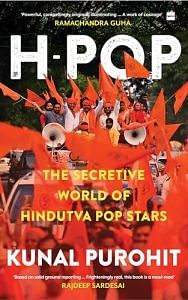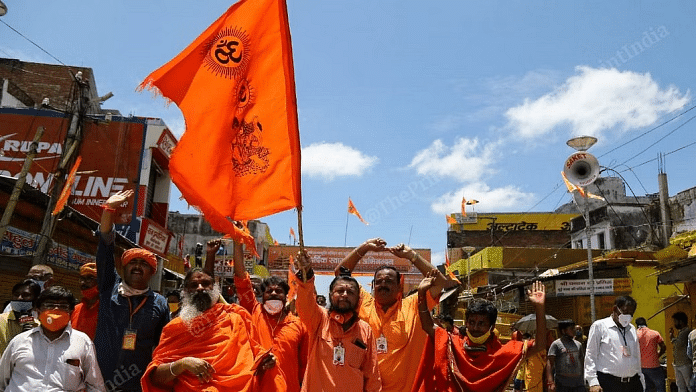In 2019, after the popularity that her song around the Pulwama suicide bomb attack brought her, Kavi’s newly born singing career reached a crossroads.
Her almost overnight initiation into singing meant that there was no clear path for her and Ramkesh to take, following Pulwama’s success. What had started as just an experiment to gauge her singing capabilities through the WhatsApp-circulated voice note had to suddenly transform into a full-fledged dive into the world of music and entertainment, resulting in a hurriedly shot music video. What was to be done next? The question plagued Kavi as well as Ramkesh.
Kavi was just one song old. She needed to do a lot more to be established and known for, before she could be, say, invited for concerts and shows. The only way for her to do that was the internet. For singers like Kavi who want to be effective content creators online, time is of the essence. With so much content waiting to be devoured at all times, a long absence online can hurt. While there is no authoritative prescription, digital marketing strategies advise YouTube creators like Kavi to post at least once to multiple times a week, for the platform to boost their growth and promote their content organically.
Kavi’s work reflected the confusion between the need to figure out her plan ahead and the pressure to be visible online. Soon after the Pulwama number, she brought out a string of songs, experimenting with various themes. About twenty days after the Pulwama song, Kavi brought out her next, a deshbhakti (patriotic) song about India becoming a vishwaguru (world leader) by reforming its social evils—from female foeticide to illiteracy and casteism. It cast subtle digs at the Muslim community without any explicit mention, by saying those who refuse to sing ‘Vande Mataram’ must not be allowed to live in India.
Beyond that one reference, it had no political overtones.
A fortnight later, with an eye on the upcoming Lok Sabha polls, Kavi released her next single, a song to boost voter enthusiasm. The song, titled ‘Matdan’, or voting, exhorted citizens to come out and vote in large numbers. The song did not show any political leaning, instead it listed general qualities that citizens should look at, while making their electoral choice:
Jiske chaal chalan mein na ho kisi kisam ka khot,
Jo nahi maarta kisi janata ki bhavna pe chot
The one whose conduct is unimpeachable,
The one who will never harm people’s sentiments
Another fortnight later came Kavi’s third song, ‘Jai jawan, jai kisan’, Hail the soldier, hail the farmer. The song paid plaudits to farmers and soldiers for contributing to the nation. That same month, in April, came another song, ‘Abhiman’, Pride, hailing Lord Ram and
professing a more ethical conduct in life.
But none of them matched up to Pulwama’s success. The instant virality that Pulwama had found, the overnight sensation of being a celebrity it had lent Kavi, and the chord it had touched with a grieving nation was nowhere close to what the subsequent three songs offered. The songs barely registered among her audience.
The Pulwama song had stood out for its brazenness—it was clear to me that it sought to target Kashmiri Muslims for ‘aiding’ the suicide bomber, reaching a conclusion that even the government hadn’t come to then. Instead of asking hard questions around the government’s security strategies, it had directed the anger of its audience elsewhere—to the ‘traitors’ who had helped carry out the attack.
All that was missing in her other four songs. What was also missing was Ramkesh.
None of those four songs were written by Ramkesh. Three different poets had written them. Although the Pulwama song was not written by Ramkesh, its lyricist, poet Azad Singh Khanda Kheri, was a close friend of his, allowing Ramkesh a greater say in the way
the song shaped up.
Ramkesh could see Kavi’s career was floundering and decided to take matters into his own hands.
The duo slowed down. From releasing a song every fortnight, the two did not release any songs for a month. Finally, at the end of May 2019, Kavi brought out a new song, written by Ramkesh this time. It was called ‘Bharat ki gaurav gatha’, the proud tales of India, an eight-minute number that sought to highlight events and persons who occupy a place of pride in India’s social consciousness. It looked extensively at Hindu mythological figures—brothers like Bharat and Lakshman from the Ramayana, warriors like Bheem in the Mahabharata, among others.
The song was a slow ode to India’s Hindu mythological tales. But it didn’t click with her audience. It pushed the father-daughter duo down into more of a slump.
In the next two months, Kavi released two more songs, both focused on similar themes, highlighting Hindu religious and mythological figures like Lord Shiva and Lord Krishna. But they met the same fate as the five songs that preceded them.
Before she knew it, Kavi’s fledgling career was flailing. The father-daughter duo was not going to stop making songs, but somehow the two could not recreate the high that the Pulwama song had gotten them.
Yet, they decided to continue trying. On 4 August 2019, Ramkesh, Kavi and a cameraperson left Rohtak and headed towards Jaipur, Rajasthan, six hours away. On the agenda was shooting several videos for some of their upcoming songs. Ramkesh had written the songs and composed the tunes.
Midway through the day, when the group took a break, a flash of news on his phone caught Ramkesh’s eye. There was a buzz that the Narendra Modi government was slated to take a major decision on an issue related to Jammu and Kashmir. News reports were not sure what it was going to be. There were rumours of various kinds.
Ramkesh knew what this was going to be. He gathered his group, told them that he was calling off the shoot and that they would need to head back to Rohtak immediately. A song had to be written, recorded and shot within the next twenty-four hours.
Their lives were going to change forever.
That night, Ramkesh stayed up till late, glued to the news for updates. His suspicions only strengthened when the authorities in Jammu and Kashmir placed severe restrictions on public movement, by shutting down educational institutes and restricting public mobility in the capital city of Srinagar.
Imposing a lockdown, authorities started enforcing curbs on activists and political leaders, placing hundreds under house arrest starting midnight of 4 August.
The next morning, his suspicions were proved correct. In the Rajya Sabha at 11 a.m., Union Home Minister Amit Shah announced that the government was abrogating Article 370 and Article 35-A of the Indian Constitution, both of which effectively granted a special status to the state of Jammu and Kashmir and, thereby, greater autonomy for the region and special rights for its residents.
The decision was momentous, especially since it came on the backs of a decades-old demand by the Hindu right-wing to scrap these special powers to Jammu and Kashmir and ‘integrate’ the region better into mainland India.
Ramkesh got to work quickly—he knew that an event as big as this was likely to remain a talking point for days. Hungry for news, updates and opinions, Indians were likely to log on to the internet and look for it all. And when they do that, they were very likely to use video platforms like YouTube, rather than search and read through other text formats.
Ramkesh knew he had to be quick. He started writing a song on this massive announcement for Kavi to perform. Within minutes, he was ready with the verse.
In the next hour, Kavi got ready, memorized her lines and was all set to record the song. At 4 p.m., she went into a studio and was done recording in an hour, with just a few re-takes.
Then, she started getting ready for the shoot. She donned a soft pink kurta with a white pyjama and an orange Nehru jacket.
Her pagdi for the occasion reflected her sentiment— tricoloured, with broad strokes of orange, white and green running through it. They didn’t have time for an elaborate shoot, so Ramkesh and Kavi decided that the video would just have to be Kavi standing before a green screen. With that, the video editor, during post-production, would have the option of adding a different backdrop behind Kavi, instead of making it look like they’ve shot the video at home.
They rushed to the studio and got started on the shoot. It didn’t take much time, just some shots of Kavi swinging her arms, pointing her fingers towards the camera while lip-syncing the words. Within hours, the shoot was done, and the video was sent to Bhurra, the editor, in his studio in Karnal.
Bhurra worked through the night, while Kavi spent a sleepless one. At 6 a.m., she rushed to the studio. The video was yet to be edited completely—but she kept pushing Bhurra. Finally, the edit was over, and the song was uploaded on YouTube.
By then, Kavi was so exhausted that she fell asleep even before the song was finally uploaded.
The song turned out to be an uncritical, unabashed backing of the government’s move to scrap the two constitutional Articles. It likened the occasion to a ‘sacchi Diwali’, the real Diwali, for India and Indians and billed the occasion to be heralding a new era for both the region and the country.
70 saal se lagi bimari, aaj uska ilaaj hua
Hua andhera door desh ka, aaj hai roshan Taj hua.
Na ab patthar barse na Khushi ki raah ko mundenge,
Ab Kashmir ki ghaati mein Shri Ram ke naare goonjenge.
A 70-year-old illness, has finally found a cure,
The country’s darkness dispelled, the Taj now shines bright.
Nor will stones be hurled anymore, nor will happiness escape,
In the Kashmir Valley, chants of Shri Ram will now be heard.
Apart from praising the Modi government’s actions—‘Saari duniya dekh rahi aaj bharat ka jalwa hai’, the whole world is watching India in its full splendour today—the song insidiously weaponizes the event to attack any criticism that might emerge against it. Even before the Modi government, the BJP and the Hindu right-wing could possibly respond, it labelled all criticism of the decision as treasonous and all critics as traitors.
The song drew harsh, bold lines between those who backed the decision, by calling them nationalists, and those who opposed it, by calling them traitors. Lines like ‘Desh bhakht hai jhoom rahe, gaddaaron ki aankh mein paani hai’, true patriots are delirious, but traitors are shedding tears, and ‘Jo desh mitana chahte the, woh aaj baith kar royenge’, those who wanted to obliterate us, will sit today and bawl, were meant to do just that: delegitimize any criticism of the move pre-emptively.
Kavi woke up to a call from her father. Within just a couple of hours, the song had racked up 850,000 views on YouTube, with over ten thousand comments from people.
Kavi was a star, again.
 This excerpt from Kunal Purohit’s ‘H-Pop’ has been published with permission from Harper Collins.
This excerpt from Kunal Purohit’s ‘H-Pop’ has been published with permission from Harper Collins.



